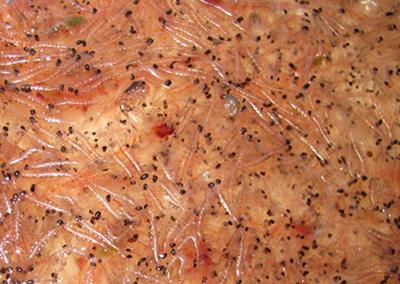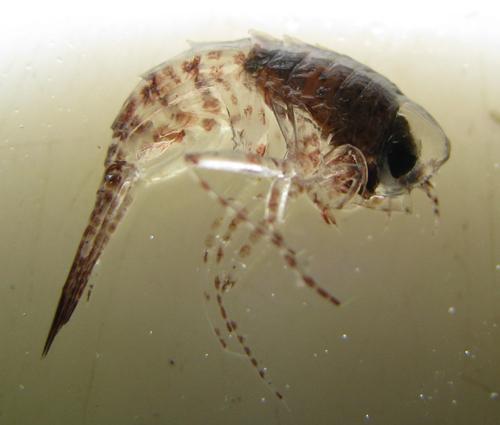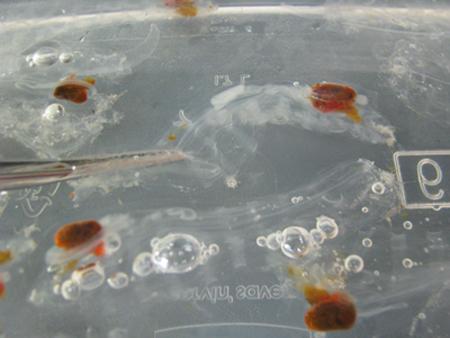Zooplankton Soup
SOUTHERN OCEAN– Krill get all the fame and glory as far as Southern Ocean zooplankton are concerned, and they certainly deserve it. But they only make up about half of the zooplankton biomass. So what about the critters that comprise the other half? They are primarily a soup of salps (pelagic tunicates) and crustaceans, such as amphipods, copepods, and euphasiids (krill-like animals), as well as worms and other crazy bug-like critters.

The zooplankton soup featuring all the major players: Krill (Euphausia superba), “T-mac” (Thysanoessa macrura), Euphausia crystallorophias (the krill-like ones that appear more orangeish/red), and “the angry one” Themisto gaudichaudii (black amphipod).
Zooplankton in the Southern Ocean are quite large when compared to their temperate water counterparts. Slow growth and delayed maturation result in a larger size in some Antarctic invertebrates, a phenomenon referred to as Southern Ocean Gigantism. This makes our job of picking the invertebrates from the zooplankton soup much easier. Amphipods can be in excess of 60-70 millimeters (but typically more like 10 mm); we have netted salps larger than 120 mm.

A particularly large Themisto gaudichaudii (predatory amphipod). From head to tail, he is over 20 mm.
Some of the amphipods and worms we find are voracious predators and actively hunt in the water column. Though they are small in relation to us, I can imagine the fear they instill in their prey. Themisto gaudichaudii, also known to us as “the angry one,” and chaetognaths, a type of arrow worm with large hooks and grasping spines for teeth, are particularly frightening. Even after the trauma of being hauled up in a net, dumped into a tray and crushed with tweezers, Themisto gaudichaudii still frantically grasp at anything they can get close to. Chaetognaths chomp with their bristly grasping spines at anything and everything, including other chaetognaths, their own body, and our skin if we let them. Though they are far too small to cause us any damage, they cling so hard to the unfortunate critters they manage to get a hold of that we have to rip them apart. No fun if you are a small euphasiid!

View from under the microscope of a Chaetognath worm (close-up of its grasping spines) and copepod, Pareucheata antarctica. (For a sense of scale, the copepod is only a couple mm in size.)
There are good reasons why we painstakingly identify and count individual zooplankton critters at the microscopic level (where we find most of the copepods and euphasiid larvae.) Zooplankton species assemblages and abundance are indicators of distinct water masses and allow us to determine how ocean currents change from year to year. Moreover, we can also detect long-term variation, including regime shifts (for instance, La Niña or El Niño) and climate change. Because krill are our primary focus, we still don’t know a lot about most of the other zooplankton species, including their role in the ecosystem or what the changes in distribution and abundance mean. Future studies hope to tackle this more.











so im not very good with all this plankton stuff, but i have a kiddie pool in my yard, growing algae, there are little almost translucent worm like things swimming around, is that plankton??? or a live form of algae??? we live in a warm, humid area if that helps… thanks.
Hi Jessica,
Gosh I am not sure what you have living in your pool! I would guess that what you have swimming around in your pool is some kind of insect larvae. The beauty of living in a humid area!
Best wishes,
Cassandra
wow dude thats obviously mysquito larva 100%
Very nice pics!! I have worked on subarctic zooplankton and am a Themisto nut.
We have libellula (arctic) abyssorum (deep) and compressa (Atlantic). We found huge T libellula
in seal stomachs (they are much better samplers than a plankton net. I’m hoping to use an Isaacs Kidd midwater trawl which can be towed at up to 15 knots.
hola, como profesora de biologia me gusta trabajr con alumnos y ahora queremos hacer un proyecto de investigacion….. me gustaria enfocar la biodiversidad del anfipodo temesti y analizarlos con los estudios que hemos realizado en la cuarta region de chile…. y quizas extrapolar al analisi de masas de hielo en la cordillera habrán los mismos macroinvertebrados
gracias
espero que me puedan ayudar